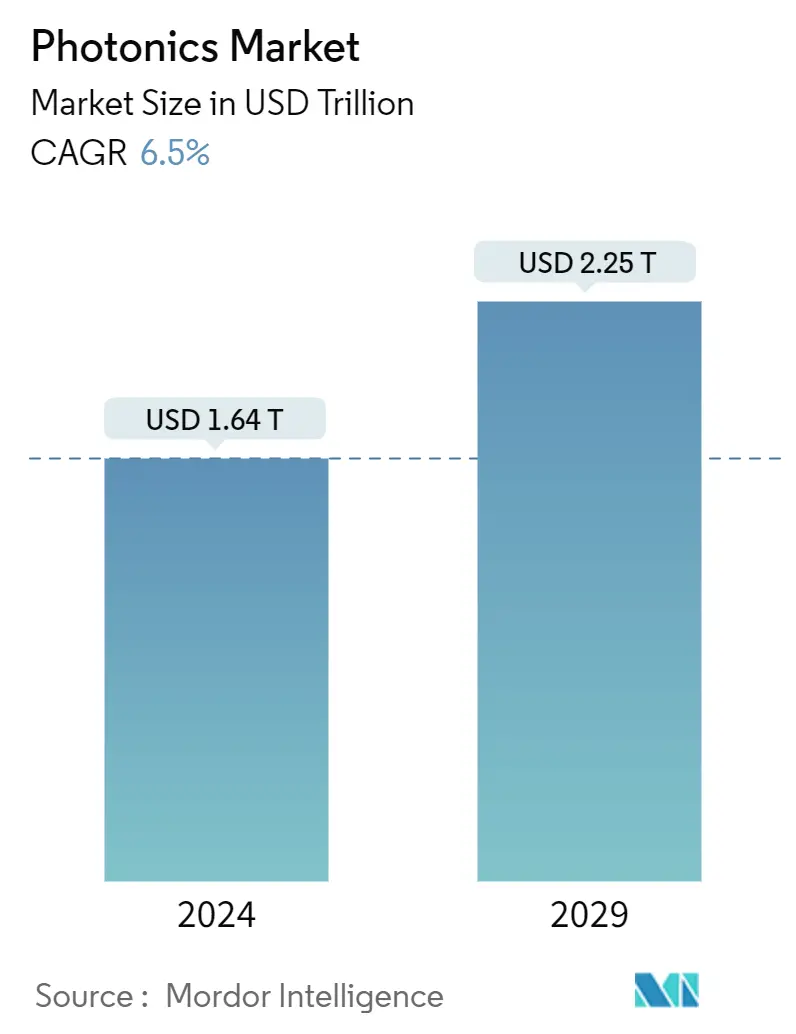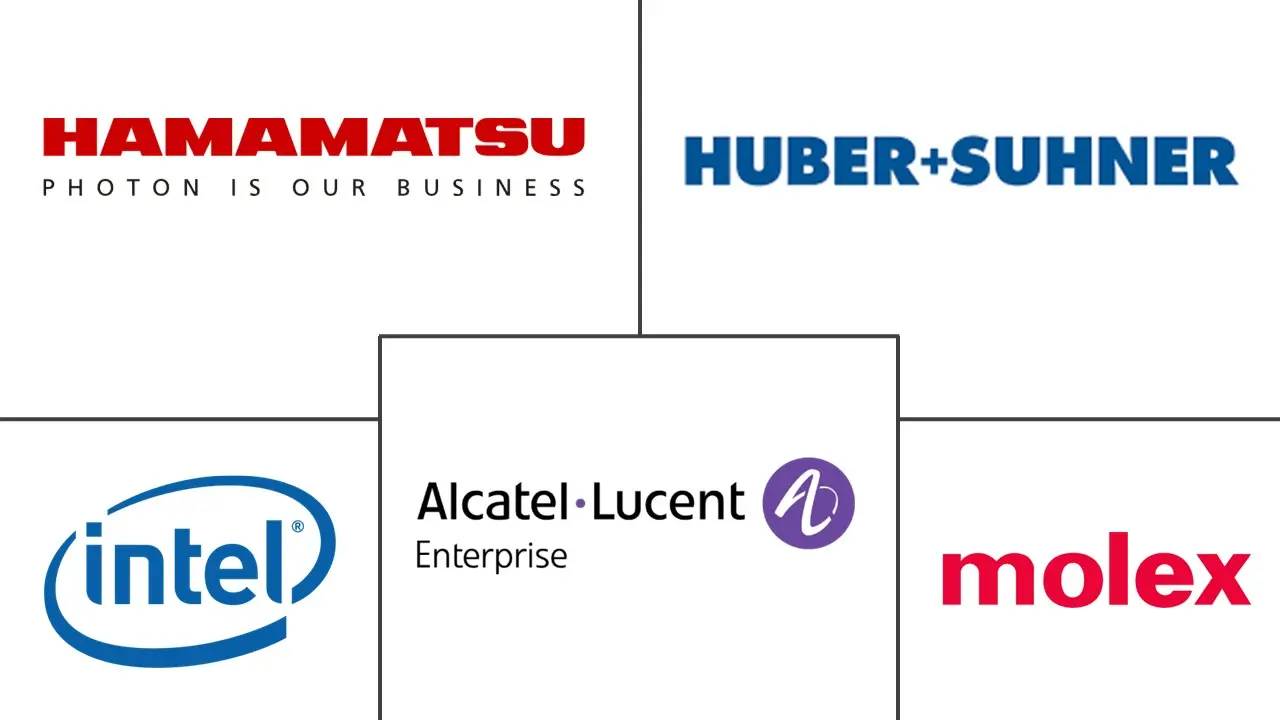Market Size of Photonics Industry

| Study Period | 2019 - 2029 |
| Market Size (2024) | USD 1.64 Trillion |
| Market Size (2029) | USD 2.25 Trillion |
| CAGR (2024 - 2029) | 6.50 % |
| Fastest Growing Market | Asia Pacific |
| Largest Market | Asia Pacific |
Major Players
*Disclaimer: Major Players sorted in no particular order |
Photonics Market Analysis
The Photonics Market size is estimated at USD 1.64 trillion in 2024, and is expected to reach USD 2.25 trillion by 2029, growing at a CAGR of 6.5% during the forecast period (2024-2029).
Photonics involve radiant energy (such as light), whose fundamental element is the photons and waves that can cure diseases, explore the universe, and even solve crimes. They involve the generation, manipulation, transmission, detection, and utilization of light and other forms of electromagnetic radiation. Photonics is widely regarded as a critical enabling technology for developing smart systems that efficiently use energy without sacrificing overall system efficiency. Many verticals, including healthcare, automotive, communications, manufacturing, and retail, are leveraging this technology to attain higher efficiency, driving the industry’s growth. Investments from these sectors also have witnessed significant growth in recent past.
- With photonics being a core technology of multiple industries, the industry outlook shows that the consumption of the technology is witnessing rapid growth, with the market expanding in new verticals. Over the past few years, there has been an increasing trend of LiDAR or additive manufacturing in photonics. LiDAR has been used to study the atmosphere's distribution of gases and contaminants for decades. In recent years, it has become a critical technology for autonomous driving. The advancements in LiDAR mapping systems and their enabling technologies have penetrated different verticals, like aerospace and defense, corridor mapping and topographical survey, automotive, mining, oil and gas, and other verticals, which are increasing the global market’s scope.
- In the United States, the largest companies, such as Google, Microsoft, and Facebook, are the primary force driving the photonics market, necessitating optimizing the data transmission process for respective data centers. The country also provides a favorable environment for technological advancements and expansions. Furthermore, the significant funding landscape in the US silicon photonics devices industry has encouraged organizations and start-ups to invest in the expanding photonics market.
- Moreover, an article titled "A Survey on Silicon Photonic in Deep Learning," published by the Association of Computing Machinery stated that deep learning has led to exceptional success in solving some extremely tough problems in disciplines, including computer vision, natural language processing, and general pattern recognition. These achievements are the product of decades of research into better training methodology and deeper neural network models, as well as developments in deep neural network hardware platforms for training and execution. Many application-specific integrated circuit (ASIC) hardware accelerators for deep learning have received attention in recent years due to their improved performance and energy efficiency over standard CPU and GPU designs.
- According to this industry analysis report, the industries require a high level of initial investment to integrate such photonics technology for automation purposes. The high cost of automated systems is concerned with effective and robust hardware and efficient software. Automation equipment requires high capital investment to invest in smart production (an automated system can cost millions of dollars to install, design, and fabricate). Thus, industries rely on the existing technologies available at a lower price, ultimately challenging adoption.
- Apart from the direct impact evident in the supply chains and production of photonic solutions, the aftereffects of the pandemic are also impacting the growth of the market, as highlighted in the industry analysis report. For instance, the ongoing threat of recession looming over various regions, including the United States, may negatively influence the market's growth, as the economic uncertainty will prevent consumers and businesses from spending more on high-value products, which may impact the growth rate of the market studied.
- The COVID-19 pandemic influenced the overall semiconductor manufacturing market from the demand and supply sides. In addition, the global lockdowns and closure of semiconductor plants also fueled the supply shortage. The effects were also reflected in the market studied. However, many of these effects were short-term. Precautions by governments worldwide to support the automotive and semiconductor sectors helped revive the industry’s growth.
Photonics Industry Segmentation
Photonics is an area of study involving the use of radiant energy (such as light), whose fundamental element is the photon and waves that can be used to cure diseases, explore the universe, and even solve crimes.
The scope of the study focuses on the industry analysis of photonics-enabled systems sold globally, and market sizing encompasses the revenue generated through photonics-enabled systems sold by various market leaders. The study also tracks the key market parameters, underlying growth influencers, and major vendors operating in the industry, which supports the market estimations and growth rate during the forecast period. This industry outlook report further analyzes the overall impact of key macroeconomic trends on the ecosystem. The report's scope encompasses market sizing and forecast for segmentation by end-user industry and geography.
The photonics market is segmented by end-user industry (consumer, aerospace and defense, display, solar, LED lighting, medical and bio-instrumentation, industrial and manufacturing, automotive, and other end-user industries), by geography (North America [United States, Canada], Europe [United Kingdom, Germany, France, Italy, and Rest of Europe], Asia-Pacific [Japan, China, India, Taiwan, South Korea, and Rest of Asia-Pacific], and Rest of the World). The market size and forecasts for the above-mentioned market segments are provided in terms of value in USD.
| By End-user Industry | |
| Consumer | |
| Aerospace and Defense | |
| Display | |
| Solar | |
| LED Lighting | |
| Medical and Bioinstrumentation | |
| Industrial and Manufacturing | |
| Automotive | |
| Other End-user Industries |
| By Geography | ||||||||
| ||||||||
| ||||||||
| ||||||||
| Rest of the World |
Photonics Market Size Summary
The photonics market is poised for significant growth, driven by its integral role across various industries such as healthcare, automotive, communications, manufacturing, and retail. This technology, which involves the generation, manipulation, and utilization of light and electromagnetic radiation, is essential for developing energy-efficient smart systems. The market is expanding as sectors increasingly adopt photonics to enhance efficiency and performance. The rise of technologies like LiDAR, particularly in autonomous driving, exemplifies the broadening application of photonics across diverse verticals, including aerospace, defense, and mining. In the United States, the presence of major tech companies and a supportive environment for technological advancements further propels market growth, with substantial investments in silicon photonics devices.
Globally, the photonics market is experiencing rapid expansion, with regions like Asia-Pacific showing promising growth trajectories. Countries such as Japan, China, India, and South Korea are contributing to this growth through technological advancements and increasing demand for electronic goods. The market's fragmentation is characterized by the presence of key players like Hamamatsu Photonics KK, Intel Corporation, and Molex Inc., who are actively engaging in partnerships and acquisitions to strengthen their market position. Despite challenges such as high initial investment costs and economic uncertainties, the market is expected to continue its upward trajectory, supported by ongoing innovations and strategic collaborations.
Photonics Market Size - Table of Contents
-
1. MARKET INSIGHTS
-
1.1 Market Overview
-
1.2 Industry Value Chain Analysis
-
1.3 Industry Attractiveness - Porter's Five Forces Analysis
-
1.3.1 Bargaining Power of Suppliers
-
1.3.2 Bargaining Power of Buyers/Consumers
-
1.3.3 Threat of New Entrants
-
1.3.4 Threat of Substitute Products and Services
-
1.3.5 Intensity of Competitive Rivalry
-
-
1.4 Impact of COVID-19 Aftereffects and Other Macroeconomic Factors on the Market
-
1.5 Technology Snapshot
-
-
2. MARKET SEGMENTATION
-
2.1 By End-user Industry
-
2.1.1 Consumer
-
2.1.2 Aerospace and Defense
-
2.1.3 Display
-
2.1.4 Solar
-
2.1.5 LED Lighting
-
2.1.6 Medical and Bioinstrumentation
-
2.1.7 Industrial and Manufacturing
-
2.1.8 Automotive
-
2.1.9 Other End-user Industries
-
-
2.2 By Geography
-
2.2.1 North America
-
2.2.1.1 United States
-
2.2.1.2 Canada
-
-
2.2.2 Europe
-
2.2.2.1 United Kingdom
-
2.2.2.2 Germany
-
2.2.2.3 France
-
2.2.2.4 Italy
-
2.2.2.5 Rest of Europe
-
-
2.2.3 Asia-Pacific
-
2.2.3.1 Japan
-
2.2.3.2 China
-
2.2.3.3 India
-
2.2.3.4 Taiwan
-
2.2.3.5 South Korea
-
2.2.3.6 Rest of Asia-Pacific
-
-
2.2.4 Rest of the World
-
-
Photonics Market Size FAQs
How big is the Photonics Market?
The Photonics Market size is expected to reach USD 1.64 trillion in 2024 and grow at a CAGR of 6.5% to reach USD 2.25 trillion by 2029.
What is the current Photonics Market size?
In 2024, the Photonics Market size is expected to reach USD 1.64 trillion.

